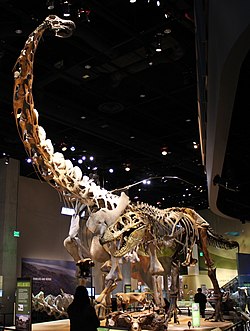Alamosaurus
|
Alamosaurus Temporal range: Late Cretaceous, 70–66 Ma |
|
|---|---|
 |
|
| Restored skeletons of Alamosaurus and Tyrannosaurus at Perot Museum | |
| Scientific classification | |
| Kingdom: | Animalia |
| Phylum: | Chordata |
| Class: | Reptilia |
| Clade: | Dinosauria |
| Order: | Saurischia |
| Suborder: | †Sauropodomorpha |
| Clade: | †Neosauropoda |
| Clade: | †Macronaria |
| Clade: | †Titanosauria |
| Clade: | †Lithostrotia |
| Family: | †Saltasauridae |
| Subfamily: | †Opisthocoelicaudiinae |
| Genus: |
†Alamosaurus Gilmore, 1922 |
| Type species | |
|
†Alamosaurus sanjuanensis Gilmore, 1922 |
|
Alamosaurus (/ˌæləmoʊˈsɔːrəs/; meaning "Ojo Alamo lizard") is a genus of titanosaurian sauropod dinosaurs, containing a single known species, Alamosaurus sanjuanensis, from the late Cretaceous Period of what is now southern North America. Isolated vertebrae and limb bones indicate that it reached sizes comparable to Argentinosaurus and Puertasaurus, which would make it the largest dinosaur known from North America. Its fossils have been recovered from a variety of rock formations spanning the Maastrichtian age of the late Cretaceous period. Specimens of a juvenile Alamosaurus sanjuanensis have been recovered from only a few meters below the Cretaceous-Paleogene boundary in Texas, making it among the last surviving non-avian dinosaur species.
Alamosaurus was a gigantic quadrupedal herbivore with a long neck and tail and relatively long limbs. Its body was at least partly covered in bony armor. Though most of the complete remains come from juvenile or small adult specimens, three fragmentary specimens, SMP VP−1625, SMP VP−1850 and SMP VP−2104, suggest that adult Alamosaurus could have grown to enormous sizes comparable to the largest known dinosaurs like Argentinosaurus, which has been estimated to weigh 73 tonnes (72 long tons; 80 short tons). The total estimate length of Alamosaurus is estimated at 30 m (98 ft) long. Scott Hartman estimates Alamosaurus being slightly shorter at 28–30 m (92–98 ft) and is equal in weight to other massive titanosaurs such as Argentinosaurus and Puertasaurus. However, he says that at the moment, scientists do not know whether the massive tibia belongs to an Alamosaurus or a completely new species of sauropod.
...
Wikipedia
